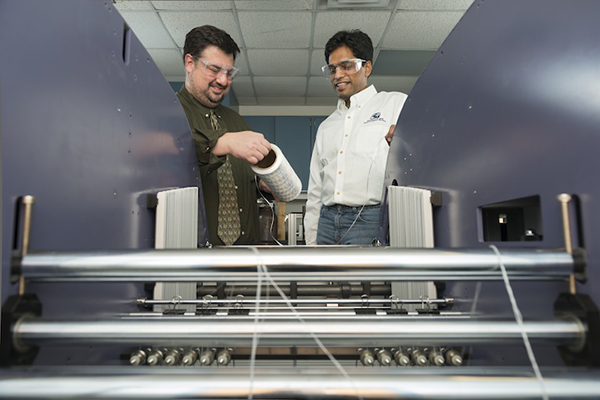
Smart ship structures
CCM researchers design multifunctional materials for electromagnetic applications
9:42 a.m., March 13, 2013--The U.S. Navy envisions the ship of the future having electromagnetic devices such as antennas integrated directly into the load-carrying structure, and researchers at the University of Delaware Center for Composite Materials (CCM) are working to help realize that vision.
Accomplishing the goal will require marrying traditional ship materials, such as structural composites, with radiating antenna elements, frequency selective surfaces, and other electromagnetic (EM)-based components.
Research Stories
Chronic wounds
Prof. Heck's legacy
It sounds simple, but researchers Mark Mirotznik and Shridhar Yarlagadda are well aware of the challenges. First, the mechanical properties of the materials have to be maintained at the same time that an EM-friendly environment is created.
Second, the constituents of advanced composites — the fibers and matrix — can be combined in a broad array of architectures, setting the stage for almost limitless possibilities, but the researchers have to sift through all of these options to identify the best material for a specific application.
Enter CCM’s supercomputer, a Silicon Graphics Altix UV1000, affectionately known to center researchers as Veyron for its speed and power.
Phase 1 of the project, which is being carried out in collaboration with the Naval Surface Warfare Center, Carderock Division, focused on developing codes to analyze existing composite structures.
“We now have efficient models for predicting the electromagnetic and mechanical properties of woven fabric composites over a very wide bandwidth,” says Mirotznik, who is an associate professor in UD’s Department of Electrical and Computer Engineering. “Now, in Phase 2, we’re going in the other direction — we’re developing design tools that will enable hybrid structural fabrics with prescribed properties to be synthesized.”
“This is a much more computationally intense task that involves a lot of intelligent guessing,” he adds. “The supercomputer is ideally suited for the task because it has a massive number of processors, enabling us to run multiple geometries at once, analyze them simultaneously, and then combine the best results to further narrow our search for the best material for a given application.”
Veyron’s capabilities will be complemented by those of a computerized loom in the Composites Manufacturing Science Laboratory at UD, which was purchased by a grant from the Navy.
“The loom enables us to make a broad array of custom composite fabrics,” says Yarlagadda, assistant director for research at CCM and research professor of electrical and computer engineering. “Just about anything we can design, we can make with this piece of equipment.”
“Overall, we believe the tools we’re developing in this project will result in a powerful means of designing useful multifunctional structures, such as radomes, by creating stacks of custom-designed hybrid fabrics.”
Mirotznik, who joined the UD faculty just four years ago from the Catholic University of America, views CCM as a national treasure. “When I travel to give talks, everyone seems to know the composites center and has an appreciation for how good it is,” he says.
“I did this type of work before I came here, but everything I did was on the computer,” he adds. “Now I’m in a place where we can make just about anything we can dream up.”
About the Center for Composite Materials
Founded in 1974, CCM conducts basic and applied research, educates scientists and engineers, and develops and transitions technology. Since 1985, CCM has been designated a center of excellence through seven programs. The center has some 250 affiliated personnel, more than $12 million in annual expenditures, and over 2,000 alumni worldwide. More than 3,500 companies have benefited from affiliation with CCM over the past three decades.
About the Supercomputer
The Altix UV1000 is made by Silicon Graphics International. CCM’s Veyron was initially configured with 384 cores (4.1 teraflops), 2.5 terabytes (TB) of globally shared memory, and 38 TB of hard disk space. It is scalable up to 2,048 cores and 16 TB of memory (21.8 teraflops in a single system image).
Article by Diane Kukich
Photo by Evan Krape








